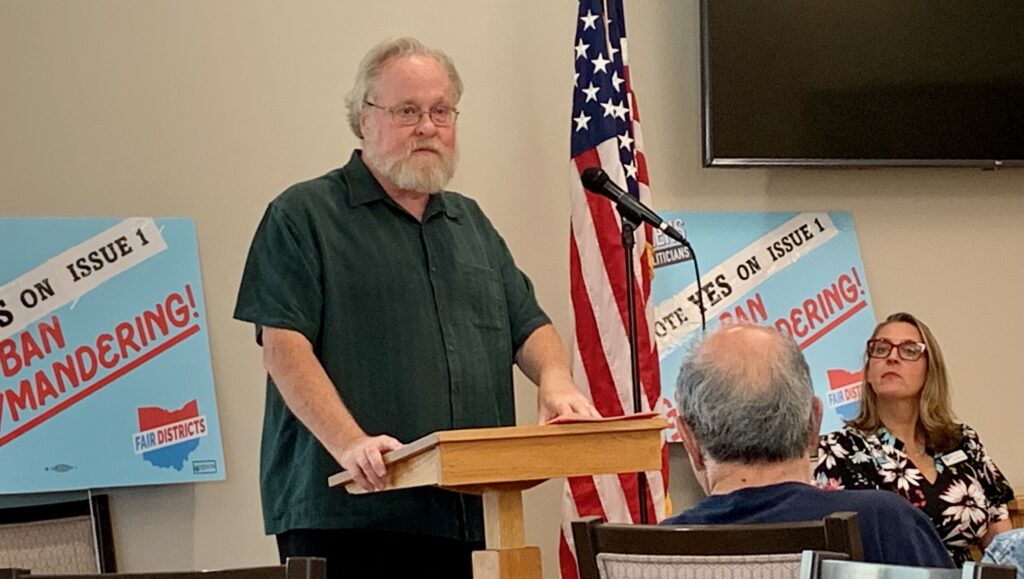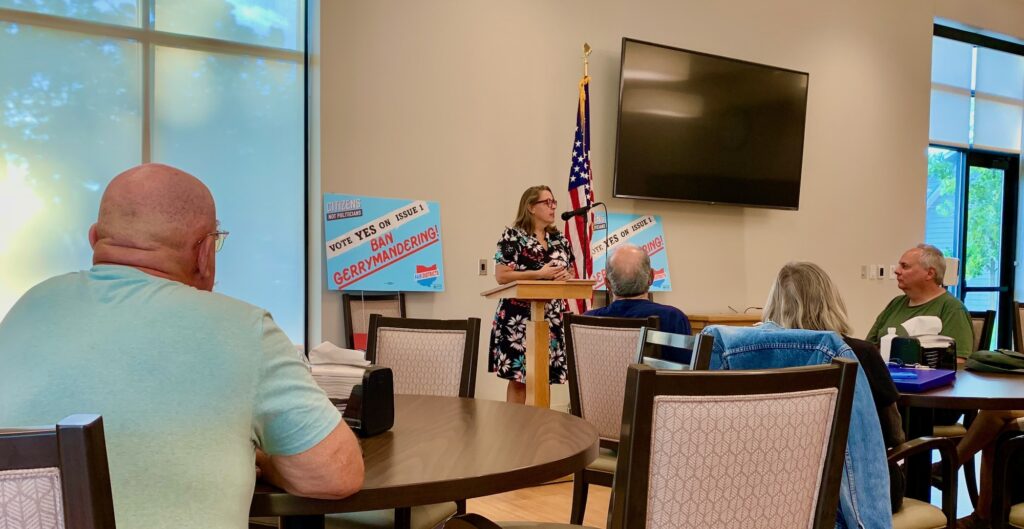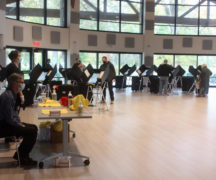By JULIE CARLE
BG Independent News
Ohio is one of the 11 most gerrymandered states in the United States. Issue 1, the “citizens, not politicians” ballot initiative in November would change that distinction.
According to a report by the World Population Review, the total number of votes cast for each major party is consistently close in Ohio; however, gerrymandering techniques known as “packing” and “cracking” enabled the party that drew the maps to win 75% of the seats (12 of 16) in 2016 despite earning only 50–60% of the votes.
A yes vote on Issue 1 “is about restoring power where it belongs–to the people of Ohio, not politicians,” said Jen Miller, executive director of the League of Women Voters of Ohio, during a public meeting Monday in Bowling Green.
Issue 1 would put 15 citizens–five each of Republicans, Democrats and Independents–in charge of drawing new maps and fair districts for Congressional and General Assembly delegations in Ohio. “Not politicians. Not elected officials. Not party leaders or lobbyists,” Miller emphasized. “It is a citizens’ commission.”
[RELATED: Democratic leaders join in fight against Ohio Ballot Board summary of anti-gerrymandering proposal]
When politicians draw voting districts to assure their own re-election, and their friends get re-elected it’s called gerrymandering, she said. “It hurts every single one of us.”
In the past, the Ohio Supreme Court struck down politician-drawn maps seven times, and the politicians ignored the rulings. As it stands, the process is unconstitutional, Miller said.
Politicians on both sides of the aisle have gerrymandered, she said. Once they have the power, they want to keep it. “That is human instinct,” she said.
With equal numbers from each party on the commission, no group would have an outsized role in creating the maps. They would be citizens who have no self-interest. Their goal is to create fair districts that result in fair elections, she said. It would also be the first time Independents would be represented in the process.
When asked why this time would be different from the previous efforts to create fair districts, Miller said the map-drawing process includes guardrails similar to how elections have protections across the entire process to ensure they are secure.
“There are protections throughout the entire amendment that they cannot be rigged,” she said.
In 2015 and 2018, the process included politicians and lobbyists. Those negotiations did not work.
“Now we are taking them out of the process. It wasn’t the rules that were theh problem; it was the people drawing the maps,” Miller said.
The ballot initiative gives Ohioans “a chance to rebalance our great state,” said David Jackson, president of the Bowling Green State University Faculty Association, whose members represent the interests of working people

“Sometimes political reality prompts us to get involved directly in politics,” Jackson said, referencing the association’s involvement in the 2011 Senate Bill 5. “There are so many out-of-touch lawmakers who are a real threat to working people, organized labor collective bargaining rights, safety in the workplace, basically, everything we stand for. If there is an existential threat, then we get involved.”
“A yes vote on Issue 1, we will finally have competitive elections and have actual representation instead of the extremism we’ve gotten so used to,” Jackson said. “Elections that are competitive have a higher voter turnout because people care to participate when they know the outcome isn’t a foregone conclusion.”
Competitive elections allow the people’s issues to move to the forefront. “Instead of (politicians) just having to please the voters in the primary and then the general election being a given, our issues have to be paid attention to. The will of the people has to be respected, or the politicians get thrown out of office in the next cycle, the way democracy is supposed to work,” Jackson said.
“Politicians are picking their voters instead of voters picking their leaders,” said Eric Sweeney, United Steel Workers District 1 representative.
The issue is the result of politicians at the Statehouse who are out-of-touch with voters and no longer accountable to voters, he added.
They are aware that 78% of voters across the U.S. vote a straight ticket according to their party affiliation. “With numbers like that, they don’t need accountability; they just need a solid gerrymandered district,” Sweeney said. Once they are elected, they keep their power through gerrymandered maps.
“That’s why Issue 1 is such a huge threat to them,” he said.
Michigan changes help guide Ohio
When Jackson and Dominic Wells, a BGSU political science colleague, learned that Michigan has more registered voters than Ohio despite a population of 1.7 million fewer people, they decided to look closer at the phenomenon.
Though Ohio leans more Republican and Michigan Democratic, the two states demographically are very similar. However, since 2016, the two states have “diverged politically, but they haven’t diverged demographically,” Jackson said.
Michigan implemented a citizens’ redistricting commission. There have been some issues, but “all of a sudden they have people showing up,” he said.
Gerrymandering can cause the political party that has been out of power long enough to become disillusioned, and “the bench of quality candidates goes away when the political party is crushed,” he said.
Many myths exist for Ohio’s current predicament., with gerrymandering and voter suppression at the core” he said.
“Maybe we are a 53-47 percent state, but we sure as hell aren’t an 80 percent state,” Jackson said. The people chosen to draw the maps fairly will draw fair districts because of the guardrails and checks and balances in the system.
Spread the message
The goal of the meeting and the campaign on behalf of Issue 1 is to ask people at the grassroots level to talk to coworkers, friends, family members and neighbors about the urgency for voting yes on Issue 1, Sweeney said.
“If everyone talks to two or three people, we can spread the message further,” he said.

The issue is supported “by Ohioans of all political stripes,” said Miller. “So many of you have participated in the democratic process,” she told those in attendance. Citizens of Wood County and counties across the state were instrumental in getting enough signatures–more than 535,000–to get the initiative on the ballot.
Once the signatures were validated, the Ohio Ballot Board had the constitutional duty to write fair, true, and unbiased language for the ballot. “It failed that,” Miller said.
A court case opposing the language was submitted to the Ohio Supreme Court to be addressed quickly.
“We should win that case. They should have to start the entire thing over, but I don’t expect that,” Miller said. “They might nibble at it around the edges, but it is still going to be terrible language.”
The best offensive is the neighbor-to-neighbor campaign, she said.
“It’s going to take all of us,” going to farmer’s markets and community events, writing letters to the editor, knocking on doors and texting voters. “All of you are trusted in your community for understanding democracy and caring about the future of your community and your state,” she added.
Fairness means when voter preferences change, the districts respond
“If we have fair maps, we will have meaningful elections and that means lawmakers will be responsible to us, not to extremists in their party, not to lobbyists who fund their campaigns. We need voting districts that are made for us and by us, and don’t happen to us,” Miller said.





